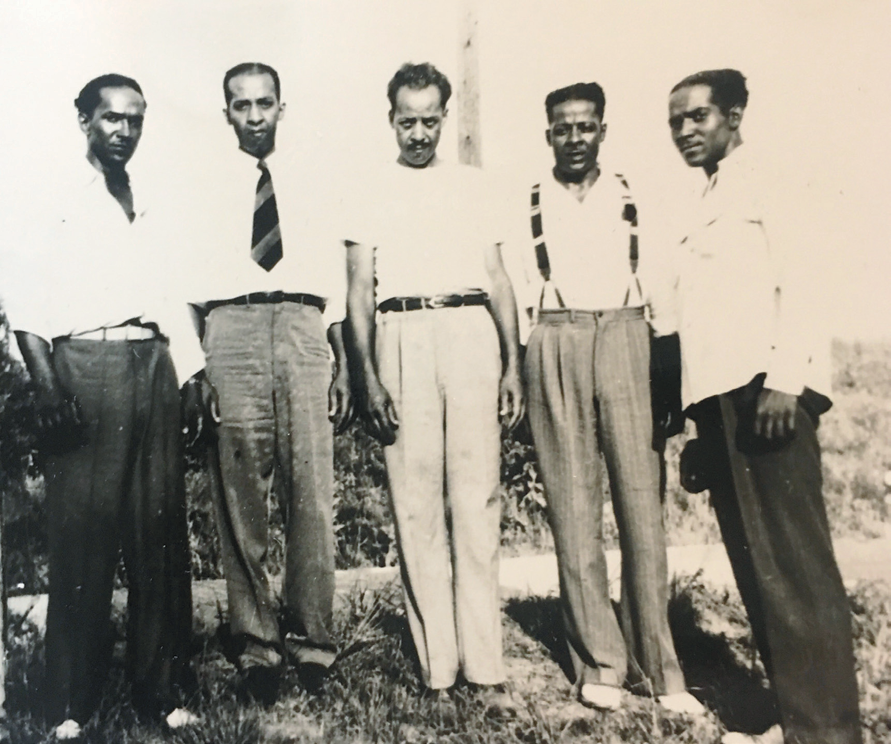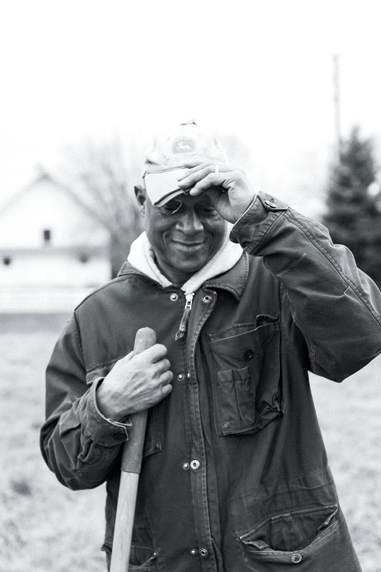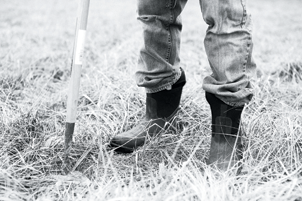Foraging Through History
For Donald Cottee, morel hunting comes easy this time of year at his Washington, Indiana, farm. He simply walks out the front door and finds them nestled among the cedar trees. He and wife, Charlet, who goes by Lynn, like to eat them dredged in flour or cornmeal and deep-fried in butter.
But Cottee’s also doing another kind of foraging, one that’s far more difficult: He’s on a mission to learn all he can about the history of his 39-acre farm, one of the oldest continuously owned family farms in the state, even predating Indiana’s statehood.
“I’m fortunate. There’s not many farms that have been in the family that long,” Cottee says. And particularly not many farms owned by African American families.
From Slave to Landowner
Like the tiny spores that spawn a morel crop each spring, the history of Cottee’s family sprang up out of the darkest soil of Indiana history. Cottee’s property is part of a larger estate that was among the first in the state to be owned by a former slave. In 1806, Cottee’s great-great-grandfather, Jacob, was one of the slaves brought to what is now Daviess County, Indiana, by Eli Hawkins, a plantation owner from South Carolina, who was an early settler in that part of the Northwest Territory. Though slavery was outlawed in the Territory, the ban was not strictly enforced and loopholes permitted slavery to persist.
When Eli Hawkins died unexpectedly in 1816, Jacob, along with another slave Isaac, who were both using the last name Hawkins by then, remained enslaved by Eli Hawkins’ widow, Catherine, and her new husband, William Merril. In 1823, however, Jacob and Isaac filed suit in the Daviess Circuit Court with the help of abolitionist attorney Amory C. Kinney and won their freedom.
“Jacob Hawkins could have run away, but he fought the legal battle, and won, not only his own freedom, but the freedom of all other African-American slaves in Daviess County,” writes Don Spillman, a Daviess County historian.
Remembering History
This sense of legacy and responsibility demonstrated in the life of his great-great-grandfather is the reason Cottee maintains the last remnant of his family’s farm today—to remember.
Slavery in Indiana
While slavery was officially outlawed in the Northwest Territory under the Ordinance of 1787, a group of proslavery officials, including then-Governor William Henry Harrison, petitioned Congress for an amendment. When that failed, the territorial government passed “An Act Concerning the Introduction of Negroes and Mulattoes into This Territory” in 1805, creating a type of legal indentured service which, according to the author of The Negro in Indiana, differed very little from slavery.
These new arrangements were set up as legal contracts between slave and owner and were recorded with the county clerk within 30 days after the arrival of the slave into the Territory. If the slave refused to sign the contract, however, the master could simply take him out of the territory within 60 days and still maintain ownership, or, as was usually the case, sell him. These indentures were legal for slaves aged 16 and over. Slaves aged 15 and under who were brought to the Territory were registered and forced to serve until the age of 35, if they were males, 32 if females. Children born to slaves in the Territory were required to serve the master of the parent until age 30 for males and 28 for females.
Since Jacob Hawkins was 16 when he arrived in the Northwest Territory in 1806, he was offered a “contract” of indentured service, and reportedly became one of the first young men in Indiana to sign such a document. In the terms offered him, “Jacob shall and will serve the said Eli Hawkins and his assigns for term of Ninety years from the day of the date hereof, he, the said Eli Hawkins and his assigns providing the said Jacob with necessary and sufficient provisions and clothing, washing and lodging, according to his degree and station. From and after the expiration of said term the said Jacob shall be free to all intents and purposes.” That means Jacob would have been 106 years old when he was finally free.
The act allowing indentures was repealed in 1810, but that didn’t stop the practice. Likewise, though slavery was banned by Indiana’s new constitution upon statehood in 1816, it wasn’t until 1820 that the Supreme Court of Indiana first upheld the constitutional ban of slavery. It took another year before the matter of indentures was addressed. In 1821, the Supreme Court made its first ruling against indentures.
In 1823, abolitionist attorney Amory C. Kinney, who had filed several of these lawsuits in Knox and Daviess Counties on behalf of enslaved and indentured men and women, helped Jacob and Isaac Hawkins file suit against William Merril in the Daviess Circuit Court contesting the legality of their servitude. The associate judges of the county, Philip Burton and Ephraim Thompson, decided with the plaintiffs, securing not only the freedom of Jacob and Isaac but that of all men and women in the county who were being held in slavery or indentures.
“It comes with a sense of not forgetting your history,” Cottee says. “This was some 40 years before the end of the Civil War. Jacob Hawkins was a free man before the Emancipation Proclamation. That was significant. And the fact that he owned thousands of acres at that time and just being African American. That’s important to have some heritage and sense of where you’re from.”
Throughout the last 150 years, various family members have owned, lived on and farmed different sections of the original estate. According to Cottee, the earlier generations gardened and kept fruit trees (apples, pears and peaches), selling fruit and vegetables at the local market. Cottee inherited his plot from his uncle Cecil, his father’s younger brother who stayed on the farm after World War II as his occupation. Cecil raised pigs and cows as meat for the extended family and farmed the tillable acres in corn and soybeans. As a young boy, Donald and his twin brother, Ronald, would spend summers with uncle Cecil. They used to hunt rabbits and fish in nearby Prairie Creek and Dogwood Lake. When Cecil passed away in 1993, Cottee inherited the property, which was by then just 32 acres.
Restore and Improve
Over the years, Cottee, who lives in Indianapolis and recently retired as a fermentation scientist from Eli Lilly, has restored and improved the property. He bought back a seven-acre corner lot that had been part of the original family property. He’s remodeling the house, which was built in 1930 by his uncle John Cottee. The original house built by Angel Gabrial and Eliza Ann Hawkins Cottee is gone, but Cottee used bricks from the old chimney to build a fire pit in his backyard. The home that Jacob Hawkins and his wife, Ellen, lived in was on a different section of the estate.
Cottee rents out the 29 acres of tillable land to a local farmer who grows corn and soybeans, and Cottee himself raises feeder calves each spring in the six-acre pasture. He also added a large pole barn for the small herd—anywhere from two to six steers each year—that he raises as beef for his family and to sell. He and his wife also have a large garden, where they grow popcorn, tomatoes, green beans, peppers and sweet corn to enjoy all summer and share with family and friends. The couple spends weekends and vacations down on the farm.
Eventually, Cottee plans to leave the farm to his two daughters, Jessica and Lauren, but besides just preserving the farm for his own family Cottee hopes to receive recognition from the Hoosier Homestead Award Program, which recognizes farms that have been owned by the same family for 100 years or more. “I could sell [the farm] and make a bunch of money, but in the end that money doesn’t have any history,” says Cottee, who also owns the Korea Tae Kwon Do Academy on the northwest corner of Indianapolis. “For my family, for my uncles, it meant a lot I think. They’re all buried down there.”
Moving Forward
But for all the pride that defines this family legacy of courage and perseverance, does Cottee ever see the farm as a reminder of the evils of slavery and the lingering racism that is present still to this day?
“I grew up in Terre Haute in the ’60s. I was called the N-word, and I had rocks thrown at me,” Cottee explains “But my parents taught us not to be that way. The past is what it is. For me, it’s something you have to remember so that you don’t go back there. Getting rid of historical things, to me, doesn’t make sense because how do you remember where you came from if you destroy what you had?”
Instead, Cottee shines the light of optimism, loyalty and hard work on what was sown in darkness. Rather than producing hate and bitterness, he finds a landscape of hope and gratitude waiting just outside his front door.
“That’s what I’m doing,” Cottee says. “Moving forward. Keeping things going. Making it better.”
A Family Legacy
After winning his freedom, Jacob Hawkins went on to marry Ellen Embrey, who also had been brought to Indiana as a slave from South Carolina, and the couple had 11 children.
In 1831, they purchased a 1,000- acre tract outside of Washington, Indiana. Portions of that property were later sold to help develop the Wabash & Erie Canal, the Ohio & Mississippi Railroad and coal mining operations in southern Indiana.
Upon the death of Jacob and then Ellen Hawkins, their property was divided up among their 11 children, including the daughters. In fact, their middle daughter, Eliza Ann Hawkins, is Donald Cottee’s great-grandmother. She married Angel Gabrial Cottee, and their son, Angel Odrow Cottee, was Donald’s grandfather. Donald’s father, Lloyd, was the sixth of eight children.
Donald Cottee inherited his plot from his uncle Cecil Cottee, his father’s younger brother who stayed on the farm after World War II as his occupation.











